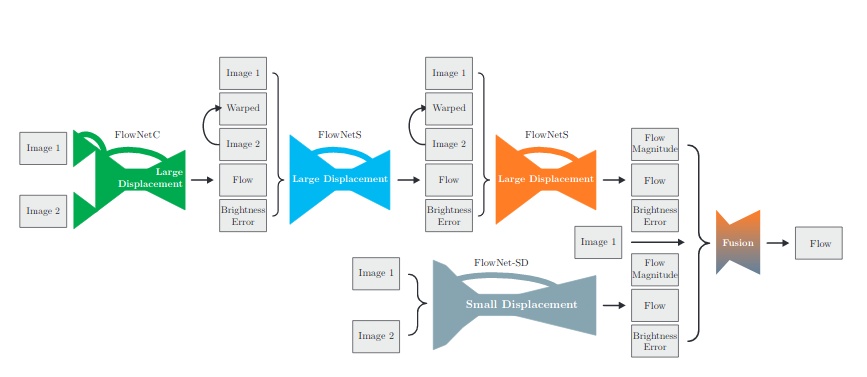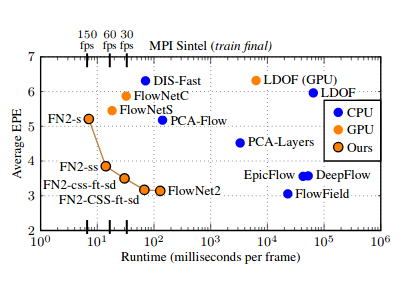FlowNet 2.0: Evolution of Optical Flow Estimation with Deep Networks
last modified : 24-06-2020
General Information
- Title: FlowNet 2.0: Evolution of Optical Flow Estimation with Deep Networks
- Authors: Eddy Ilg, Nikolaus Mayer, Tonmoy Saikia, Margret Keuper, Alexey Dosovitskiy, Thomas Brox
- Link: article
- Date of first submission: 6 Dec 2016
- Implementations: (if any found)
Brief
In this paper, the authors focus on improving optical flow estimation with deep learning. They work on the previously introduced FlowNet and increase the precision of the network through 3 main improvements:
- Data scheduling: They show that the order of the data when presented to the network has an impact on the final precision
- Iterative learning: They stack networks to carry out iterative refinement. To simplify the work of the added networks, they use wrapping operations
- Small displacements improvements: They introduce a new dataset and fuse their architecture with a network specialized in small displacement
They also introduce small version of their networks to improve on the speed of prediction while maintaining the precision at the original FlowNet's level.
With the proposed improvements, they outperform the previous FlowNet network and reach precisions that matches the state of the art.
How Does It Work
Dataset scheduling
They show that for a given a learning rate schedule, it is better to first train on a simple dataset and then to finetune on the complicated one. It is still unclear to me how they choose the learning rate schedule and why they train and finetune on the same dataset for some of the experiments.
Iterative learning
They stack networks in order to improve the results in an iterative manner. The first networks gets the two input images and the following ones gets the two images and the flow prediction from the previous network. They also wrap one of the images input to the added networks using the predicted flow to simplify the prediction work (see image below for more visual details).
Displacement improvements
The FlowNet network seems to have trouble estimating small displacement. To understand why, they analyze the training data previously used and find that it contains mainly large displacement. They introduce a new dataset with small displacements to improve on this predictions.
They also carry some modification on their architecture to improve the results. The final network is shown below:

Results
The results are summarized in the following graph:

They show large speed/precision improvements and are on par with the state of the art methods (EPE = End Point Error).